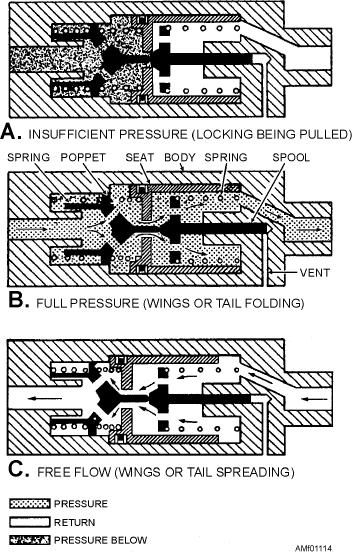
A check valve, either a poppet or ball, is installed
between the fluid ports of the body, and is held against
a seat by the check valve spring. The seated check
valve spring prevents fluid flow through the valve. The
plunger, driven into the valve by the first unit, unseats
the check.
The balanced sequence valve will not permit fluid
flow in either direction unless the plunger is depressed.
This check valve, with equal working areas (balanced),
cannot be unseated by fluid pressure in either
direction. Thermal relief valves are needed in this
system.
The unbalanced valve can be unseated by fluid
p r e s s u r e b e l ow i t w i t h o u t h av i n g t h e p l u n g e r
depressed. This movement allows thermal expansion
to be relieved. Thermal relief valves are NOT needed
in this system.
Pressure from the selector valve goes directly to
the first unit. To operate the second unit, fluid must
pass through the sequence valve, which it can do only
when the check valve is unseated. On completing its
operation, the first unit depresses the plunger on the
sequence valve, which unseats the check valve and
allows fluid to flow through the valve to second unit.
Thus, the second unit cannot operate until the first unit
operation is complete. In reverse, when contact force
is removed from the plunger, the spring extends it and
the check valve reseats.
Figure 11-14.--View of priority valve.
Improper adjustment of plungers on the
lockpins and fold actuators. These valves ensure
mechanical-type sequence valve is the most common
lockpin actuation before fold actuator operation. This
cause of trouble. If the adjustment is off, it could cause
completely automatic valve consists of a body
the second unit to operate too soon or not at all. The
containing a spool, seat, poppet, related springs, seals,
adjustment is made either on the plunger of the
and an end cap.
sequence valve or the striker that depresses the
When the wing fold selector valve is in the fold
plunger.
position, it directs fluid both to the wing lockpin and to
Adjustment should be checked at every periodic
the pressure-operated sequence (priority) valve.
inspection. If a valve leaks internally, disassemble,
System pressure drops in the wing fold system because
clean, and inspect the check valve and its sealing
of the amount of pressurized fluid needed to actuate the
surface. Replace faulty O-rings. Internal leakage
lockpins. This lowers pressure below that needed to
could cause the second unit to operate before it should.
open the pressure-operated (priority) valve.
View A of figure 11-14 shows insufficient pressure
Pressure-Operated (Priority) Sequence Valve
to unseat the spool. When lockpins have completed
The pressure-operated sequence valve, also called
their travel, system pressure builds until it overcomes
a priority valve, looks like a check valve externally.
spring tension and causes the poppet to unseat the
Like a check valve, an arrow indicates the installation
spool (view B of fig. 11-14). Fluid then flows freely
position. Figure 11-14 shows this valve installed in a
through the valve to the wing fold actuators.
wing fold system.
View C of figure 11-14 shows the free-flow
During the wing folding cycle, pressure-operated
position of the valve. When spreading the wings,
return fluid moves the seat from the spool compressing
(priority) valves sequence the movement of the
11-16

